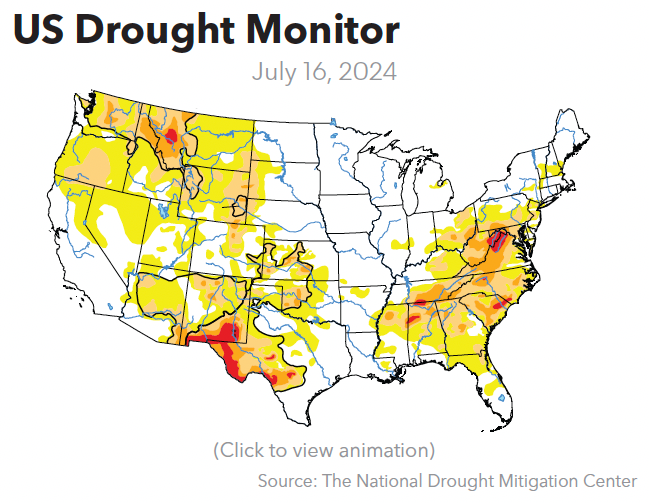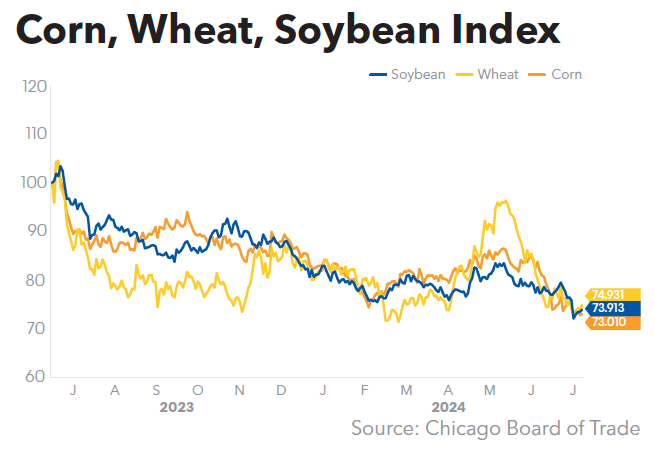Eastern Cornbelt:
Separate
storms on July 14 and July 15 caused widespread damage and power outages across
northern Illinois and northwestern Indiana. Multiple tornadoes were reported,
while 70 mph wind gusts knocked out power to thousands of customers. The
National Weather Service was still investigating at least two dozen potential
tornado paths at midweek.
Cooler
weather was reported in Ohio and Michigan as the week progressed, with a chance
of weekend showers.
Good
or excellent ratings were assigned to 73% of the corn and soybeans in Illinois
on July 14, compared with 67% in Indiana and 64-67% in Ohio. Michigan’s corn
crop was 72% good or excellent, with 62% of the state’s soybean crop falling
into those two categories.
Western Cornbelt:
A
line of strong storms in central and eastern Iowa on July 15 produced at least
one tornado and left thousands without power. The Storm Prediction Center later
called the storm a derecho, with top winds estimated at 97 mph in Dubuque
County.
Heavy rain hit southern
Missouri at midweek, producing flash floods and prompting evacuations in some
areas. Seven inches fell in less than six hours in Branson, Mo., causing Turkey
Creek at Hollister, Mo., just south of Branson, to rise 12 feet in two hours.
USDA rated 74-79% of the
corn and 72-77% of the soybeans as good or excellent in the region on July 14.
Good or excellent ratings were also assigned to 60% of Missouri’s cotton and
79% of the state’s rice crop, along with 78% of Nebraska’s sorghum crop.
Southern Plains:
Kansas
and Oklahoma residents enjoyed cooler temperatures for most of the week, with
highs topping out in the 80s. Forecasts warned of potentially strong
thunderstorms over the coming weekend in both states, however.
Lower
temperatures were also reported throughout Texas during the week, along with
spotty thundershowers in northern areas of the state. Heavy rain was reported
in New Mexico as the week progressed, while eastern Colorado saw slightly
cooler temperatures after record heat the previous weekend, when highs exceeded
105 degrees in some areas of the state.
Severe-to-extreme
drought conditions were reported across a wide swath of southern New Mexico and
western Texas in mid-July, with small areas of moderate-to-severe drought
popping up in northern New Mexico, central Oklahoma, and central Kansas.
Crop
conditions varied widely in the region. Corn in the good or excellent
categories totaled 61% of the crop in Kansas, 54% in Colorado, and 42% in
Texas, while 76% of the soybeans in Kansas fell into those two categories.
While 76% of Oklahoma’s cotton was rated as good or excellent at mid-month,
just 34% of the Texas crop came in with those ratings, along with 64% of the
acreage in Kansas.
Sorghum
rated as good or excellent totaled 61% of the crop in Oklahoma, 55-57% in
Kansas and Texas, and 47% in Colorado.
South Central:
Flash
flood emergencies were declared in central and northern Arkansas at midweek
after torrential rains hit the region on July 17. News reports said 6-11 inches
of rain fell in just five hours, resulting in evacuations in some areas as
rivers and streams rose dramatically.
Parts
of Middle Tennessee and southern Kentucky also collected some needed rain
showers at midweek, ushering in cooler temperatures after intense heat the
previous weekend. Southern Louisiana was bracing for 2-4 inches of rain late in
the week and over the coming weekend.
USDA
rated 56-63% of the corn in Tennessee and Kentucky as good or excellent on July
14, while soybeans in those two categories totaled 62% of the acreage in
Tennessee, 63% in Mississippi, 64% in Kentucky, 73% in Arkansas, and 85% in
Louisiana.
Fully
93% of Louisiana’s cotton crop was rated as good or excellent at mid-month,
compared with 81% in Arkansas and 49-50% in Mississippi and Tennessee. Rice in
the good or excellent categories totaled 89% of the acreage in Louisiana, 75%
in Arkansas and Texas, and 60% in Mississippi.
Southeast:
Much
of the Southeast was bracing for an extended period of wet weather in the
second half of July, thanks to a stalled-out cold front that brought heavy rain
to parts of the Southwest and South Central region during the week.
Thunderstorms
moved through parts of North Carolina and Virginia on July 18, triggering
severe thunderstorm watches that warned of large hail and wind gusts up to 70
mph. A wide swath of the Carolinas, Georgia, and Virginia were preparing for
2-5 inches of rain by the weekend, with 1-3 inches possible across Florida.
Earlier
drought conditions have taken a toll on crops in the Southeast. Just 9% of
North Carolina’s corn was rated as good or excellent on July 14, with 73% of
the crop rated as poor or very poor. North Carolina’s soybeans were 26% good or
excellent and 31% poor or very poor on that date.
Cotton
in the good or excellent categories totaled 40-41% of the crop in the Carolinas
and 57-58% in Alabama, Georgia, and Virginia. The peanut crop was slightly
better, with good or excellent ratings assigned to 50-55% of the acreage in the
Carolina, 58% in Georgia, 63% in Florida, 77% in Alabama, and 79% in Virginia.

